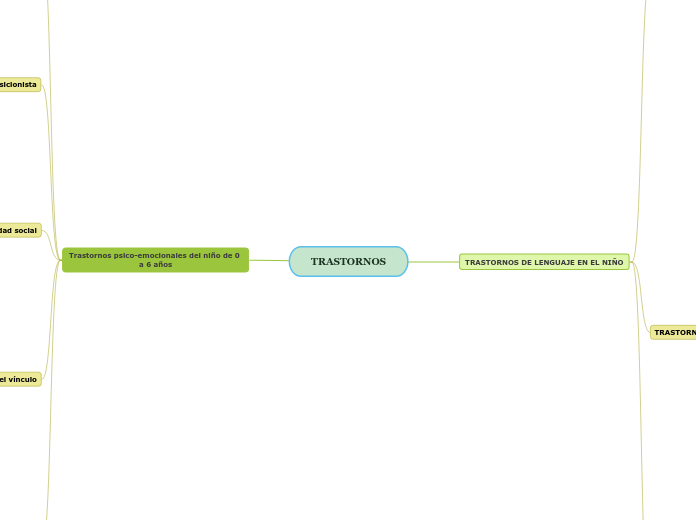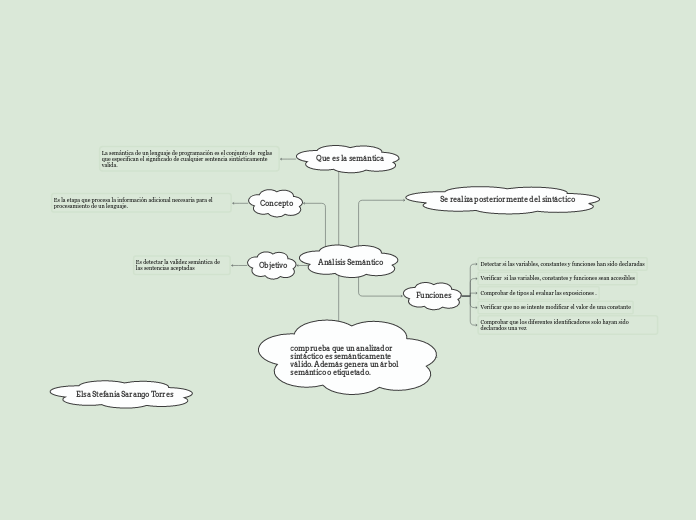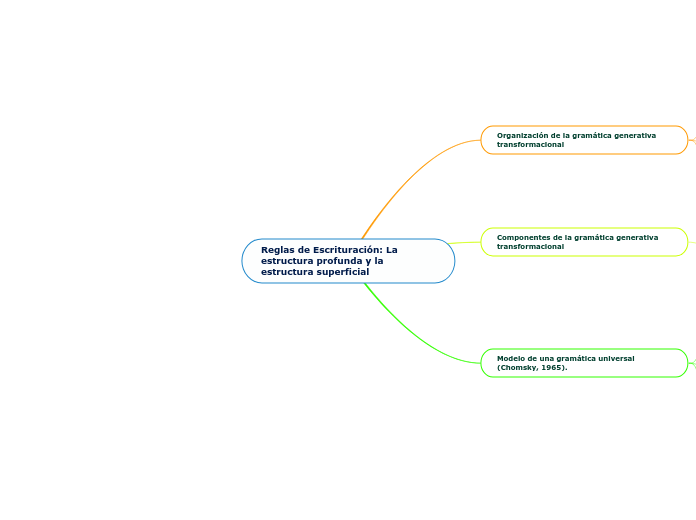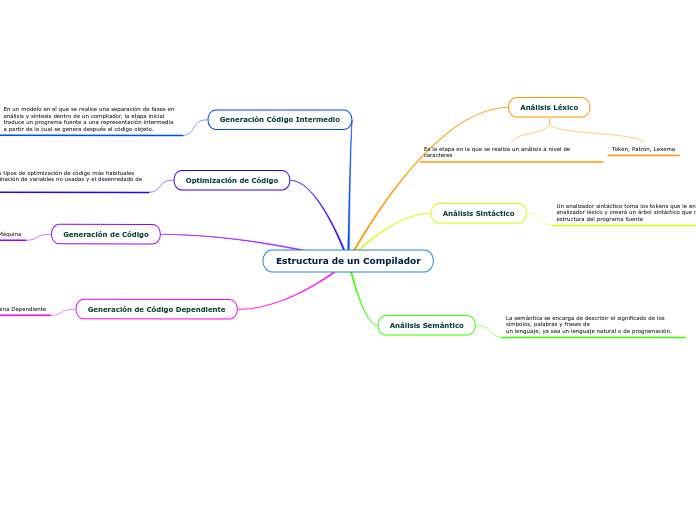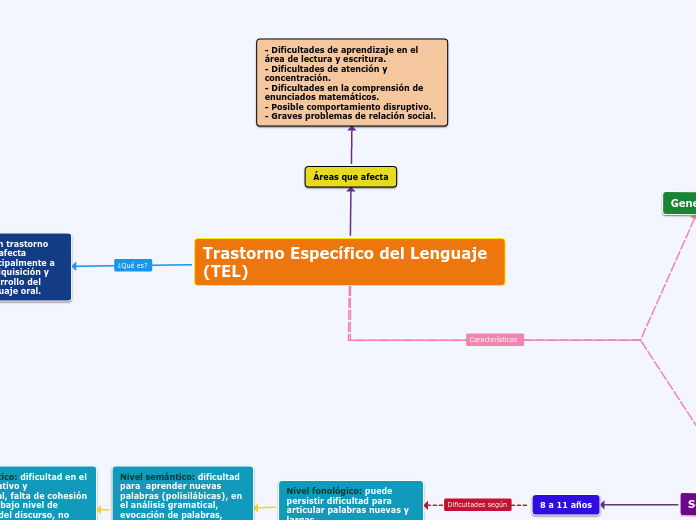TRASTORNOS
Tenses demonstrate the time of actions centered around the subject of the sentence. These actions are called verbs and change according to tenses.
Trastornos psico-emocionales del niño de 0 a 6 años
There are four Future tenses:
- Future Simple ('with Will' and 'with Going to')
- Future Continuous
- Future Perfect Simple
- Future Perfect Continuous
Depresión en la infancia
Future Perfect Simple is used for:
- an action that will continue up until a point in the future
- an action that finishes just before another time or action in the future
Some adverbs used with Past Perfect Continuous for future actions:
- for
- since
- next week
- next month
- next year
Finalmente señalar que sigue habiendo un reducido número de pruebas específicas para evaluar estos trastornos en niños, si bien, se ha avanzado bastante respecto a años anteriores en nuestro país
Las pruebas de papel y lápiz, incluyendo los autoregistros, se utilizan a partir de los seis años que es la edad normal de inicio de la lectura y escritura.
Varias son las dificultades que se presentan.
Structure:
Will + Subject + Have Been + Verb-ING
e.g. How long will they be working on that project next week?
Un segundo hace referencia a la dificultad de utilizar pruebas de autoevaluación en los niños más pequeños.
Una primera radica en la disparidad de procedimientos que dificulta la comparación entre estudios
Type in your own examples or you can also choose from the examples below.
Form of word "to be":
Will I have been being?Will you have been being?Will he/she/it have been being?Will we have been being?Will you have been being?Will they have been being?
Form of word "to have":
Will I have been having?Will you have been having?Will he/she/it have been having?Will we have been having?Will you have been having?Will they have been having?
El proceso de evaluación psicológica consiste en obtener información relevante, fiable y valida del niño y de otras personas que se relacionan con él.
Structure:
Subject + Won’t Have Been + Verb-ING
e.g. They won’t have been working on that project for two years next week.
Type in your own examples or you can also choose from the examples below.
Form of word "to be":
I will not have been beingYou will not have been beingHe/She/It will not have been beingWe will not have been beingYou will not have been beingThey will not have been being
Form of word "to have":
I will not have been havingYou will not have been havingHe/She/It will not have been havingWe will not have been havingYou will not have been havingThey will not have been having
es un trastorno complejo, que incluye alteraciones cognitivas, psicofisiológicas y motoras, que difieren según los casos
Structure:
Subject + Will Have Been + Verb-ING
e.g. They will have been working on that project for two years next week.
Examples
Type in your own examples or you can also choose from the examples below.
Form of verb 'to be':
I will have been beingYou will have been beingHe/She/It will have been beingWe will have been beingYou will have been beingThey will have been being
Form of verb 'to have':
I will have been havingYou will have been havingHe/She/It will have been havingWe will have been havingYou will have been havingThey will have been having
T. del vínculo
no siempre hacen falta grandes traumas para que un niño pueda desarrollar problemas de vinculación.
los sustitutos temporales
las instituciones internas en etapas anteriores al segundo año de vida
Las largas horas de trabajo de muchos padres
Diversas pueden ser las causas
abandono
niños que han estado en incubadoras
separaciones
Hogares para niños sin amparo filial
maltrato
Es cuando se han producido rupturas traumáticas en el lazo afectivo niño-madre desde las etapas más tempranas
T. de hipersensibilidad social
Future Perfect Simple is used for:
- an action that will be finished by a particular time in the future
- an action that starts before and continues up to another action or time in the future
- an action that will finish before a certain time in the future, but it is not known exactly when
Adverb used with Future Continuous:
- tomorrow (e.g. tomorrow by 7)
En los casos graves se acompaña de hostilidad, maldad e infamias contra el hermano menor y pudiendo mostrar comportamientos pueriles como es enfrentarse con los padres, llamar la atención con la comida, rabietas.
Structure:
Will + Subject + Have + Past Participle?
e.g. Will you have met your colleague by this time tomorrow?
Trastorno de rivalidad entre hermanos El trastorno aparece unos meses después del nacimiento del hermano menor
Type in your own examples or you can also choose from the examples below.
Form of word "to be":
Will I have been?Will you have been?Will he/she/it have been?Will we have been?Will you have been?Will they have been?
Form of word "to have":
Will I have had?Will you have had?Will he/she/it have had?Will we have had?Will you have had?Will they have had?
Miedo y desconfianza a extraños que produce una ansiedad excesiva y le impide mantener relaciones sociales normales
Structure:
Subject + Won’t Have + Past Participle
e.g. I won’t have met my friend form United States by this time tomorrow.
se da antes de los seis años de edad
Structure:
Subject + Will Have + Past Participle
e.g. I will have met my friend form United States by this time tomorrow.
T. desafiante oposicionista
Future Continuous is used:
- for an action that is likely to happen in the future and continue for an expected length of time
- for an action that will be in progress at some point in the future
- for action verbs (e.g. running)
- for predictions about future events
Adverb used with Future Continuous:
- tomorrow (e.g. tomorrow at 5 o'clock)
el validismo y vínculos emocionales sanos y estables con la separación segura, en la que el niño estará preparado y activo en su propio desarrollo.
Structure:
Will + Subject + Be +Verb-ING?
e.g. Will you be having fun at the party?
Los lazos afectivos (apego) insuficientes y negativos, no lograron el crecimiento psicológico
Structure:
Subject + Won’t Be + Verb-ING
e.g. He won’t be having fun at the party.
suele encontrarse, en el abandono real o virtual del niño en la primera infancia por parte de los padres
La conducta desafiante y de oposición de inicio temprano suele ser persistente y puede ir asociada a diferentes tipos de patología infantil y adolescente
puede tomar diferentes formas
Structure:
Subject + Will Be + Verb-ING
e.g. You will be having fun at the party.
verbalizaciones negativas, insultos, hostilidad o resistencia física con agresividad hacia las figuras de autoridad, ya sean los padres, maestros o educadores
la pasividad extrema (no obedecer sistemáticamente mostrándose pasivo o inactivo)
Type in your own examples or you can also choose from the examples below.
Form of verb 'to be':
I will be beingYou will be beingHe/She/It will be beingWe will be beingYou will be beingThey will be being
Form of verb 'to have':
I will be havingYou will be havingHe/She/It will be havingWe will be havingYou will be havingThey will be having
T. de ansiedad de separación
Future Simple is used:
- to predict an event in the future
- to invite
- to give orders
- to express willingness
- for actions that have not yet occurred but that will occur at a future date
Este trastorno suele interferir en su desarrollo y en las relaciones con sus iguales ya que estos niños suelen tener dificultades para participar en juegos, actividades, deportivas. Cuando están fuera del hogar o sin el acompañamiento de los padres, suele cursar con un elevado malestar y perturbación en el niño que lo padece, siendo frecuentes los síntomas fóbicos, de ansiedad, quejas somáticas e incluso sintomatología depresiva
Future Simple with 'will'' is used:
- to predict the future
- for something with absolute certainty
- when we're talking about a decision at the moment of speaking
- promises, requests, refusals, offers
- future facts
Some adverbs used with Future Simple:
- tomorrow
- next week
- next month
- next year
Somáticas
Structure:
Will + Subject + V1(First Form of Verb)?
e.g. Will you see Mary when she comes back from Denmark?
dolores de estómago, cabeza, pesadillas recurrentes, náuseas
Type in your own examples or you can also choose from the examples below.
Form of word "to be":
Will I be?Will you be?Will he/she/it be?Will we be?Will you be?Will they be?
Form of word "to have":
Will I have?Will you have?Will he/she/it have?Will we have?Will you have?Will they have?
Emocional
llanto, irritación, ansiedad y angustia
Conductual
Structure:
Subject + Won’t (will not) + V1(First Form of Verb)
e.g. You won’t see Mary when she comes back from Denmark.
resistencia o rechazo a acudir a la escuela u otro lugar, negarse a dormir solo o fuera de casa si no está cerca la figura de vinculación
Type in your own examples or you can also choose from the examples below.
Form of word "to be":
I will not beYou will not beHe/She/It will not beWe will not beYou will not beThey will not be
Form of word "to have":
I will not haveYou will not haveHe/She/It will not haveWe will not haveYou will not haveThey will not have
Sus síntomas se manifiestan a nivel cognitivo
Structure:
Subject + Will + V1(First Form of Verb)
e.g. I will see Mary when she comes back from Denmark.
preocupación excesiva y persistente a perder las figuras de apego o a que les suceda algo malo
Type in your own examples or you can also choose from the examples below.
Form of verb 'to be':
I will beYou will beHe/She/It will beWe will beYou will beThey will be
Form of verb 'to have':
I will haveYou will haveHe/She/it will haveWe will haveYou will haveThey will have
TRASTORNOS DE LENGUAJE EN EL NIÑO
There are four Present tenses:
- Present Simple
- Present Continuous
- Present Perfect
- Present Perfect Continuous
Otros trastornos del Lenguaje Oral
Present Perfect is used for:
- an action that occurred at a time which is indefinite and has its effect on the subject
- an action that occurred many times and has the possibility to occur in the present/future
- an action that began in the past and is still going on in the present
Some adverbs used with Present Perfect:
- just
- already
- yet
- for
- never/ever
- up to now
Disfonia
Structure:
Subject + haven’t (have not)/ hasn’t (has not) + Past Participle
e.g. She hasn’t finished the letter.
cualquier alteración que se produzca en las cuerdas vocales, en las cavidades de resonancia o en la cantidad y fuerza de la corriente de aire emitido, va a afectar a las cualidades de la voz. De esta manera, siguiendo un criterio cuantitativo, podemos distinguir dos tipos de trastornos de la voz: afonía y disfonía.
Type in your own examples or you can also choose from the examples below.
Form of word "to be":
I have not beenYou have not beenHe/She/It has not beenWe have not beenYou have not beenThey have not been
Form of word "to have":
I have not hadYou have not hadHe has not hadWe have not hadYou have not hadThey have not had
La disfonía es una alteración en las cualidades de la voz (timbre, tono, intensidad y duración). En función de su origen, pueden ser:
Disfonías funcionales, si se deben a un mal uso de la voz. En este caso, podemos distinguir: las hipertónicas y las hipotónicas.
Disfonías orgánicas, si existe una lesión en los órganos de fonación, bien de tipo congénito (malformaciones, parálisis...), inflamatorio (laringitis), y traumático (lesiones, quemaduras.
La afonía es una pérdida total de la voz que puede deberse a un estado inflamatorio agudo, a un traumatismo, a una parálisis laríngea o a cuadros psíquicos histéricos. Este trastorno no es muy frecuente en la edad escolar.
Disfemia
Structure:
Subject + have/ has + Past Participle (3rd Form of the Verb)
e.g. She has finished the letter.
Dentro de la disfemia podemos distinguir los siguientes tipos: La tartamudez se presenta de manera precoz en el niño. Se puede observar a partir de los 2 años y medio, pero es más frecuente que se desarrolle entre los 3 y 4 años.
Type in your own examples or you can also choose from the examples below.
Form of verb 'to be':
I have beenYou have beenHe/She/It has beenWe have beenYou have beenThey have been
Form of verb 'to have':
I have hadYou have hadHe/She/It has hadWe have hadYou have hadThey have had
TRASTORNOS SECUNDARIOS
Present Continuous is used to indicate the ongoing time (now).
Some adverbs used with Present Continuous:
- now, right now
- at this moment
- at the moment
- continually
- perpetually
- this year
- this season
- forever
Afasias
Structure:
BE + Subject + Verb-ING?
Are you eating now?
se define como una privación o alteración del lenguaje, provocada por una lesión cerebral focal, en un individuo que ya había adquirido el lenguaje. Su origen puede ser vascular, tumoral y traumático
Type in your own examples or you can also choose from the examples below.
Form of word "to be":
Am I being?Are you being?Is he/she/it being?Are we being?Are you being?Are they being?
Form of word "to have":
Am I having?Are you having?Is he/she/it having?Are we having?Are you having?Are they having?
La clasificación más frecuente de las afasias se hace en función de la localización de la lesión cerebral, y podemos diferenciar los siguientes tipos:
Afasia infantil: Este tipo especial de afasia hace referencia a aquel trastorno del lenguaje que se produce por una lesión cerebral en el transcurso del desarrollo del lenguaje o una vez adquirido el mismo.
Afasia global o total: la lesión destruye gran parte de las áreas del lenguaje del hemisferio dominante. Se caracteriza por un deterioro severo de las capacidades de comprensión y expresión del lenguaje
Afasia sensorial transcortical: las áreas alteradas se sitúan por detrás de la zona perisilviana, presentan buena repetición, comprensión alterada y expresión caracterizada por la normalidad en relación al débito y a la prosodia, pero con la presencia de anomias significativas.
Afasia de conducción: es el posible resultado de la evolución de una afasia de Wernicke. Se caracteriza por una alteración moderada de la expresión, así como por una expresión entrecortada, con frecuentes anomias y parafasias.
Afasia de Wernicke o receptiva: la lesión está en la parte posterior de la primera circunvolución temporal del hemisferio izquierdo (área de Wernicke). Se caracteriza por una escasa comprensión verbal, acompañada de un déficit de lenguaje expresivo, aunque en menor medida
Afasia de Broca o expresiva: la lesión está en la tercera circunvolución frontal o circunvolución frontal inferior (área de Broca). Se caracteriza por un déficit primario de la expresión del lenguaje
Disartrias
Structure:
Subject + BE not + Verb-ING
e.g. You are not eating now.
Es un trastorno de la expresión verbal causado por una alteración en el control muscular de los mecanismos del habla. Comprende las disfunciones motoras de la respiración, fonación, resonancia, articulación y prosodia. Son frecuentes en el lenguaje de los niños con déficit motor, como consecuencia de alteraciones en el sistema nervioso central
Type in your own examples or you can also choose from the examples below.
Form of word "to be":
I am not beingYou are not beingHe/She/It is not beingWe are not beingYou are not beingThey are not being
Form of word "to have":
I am not havingYou are not havingHe/She/It is not havingWe are not havingYou are not havingThey are not having
En función de la localización de la lesión distinguimos
discinética
atáxica
espástica
disartria flácida
Disglosias
Structure:
Subject + BE (am/is/are) + Verb-ING
e.g. You are eating now.
Es un trastorno de la expresión oral debido a alteraciones anatómicas y/o fisiológicas de los órganos articulatorios. Las causas son de origen periférico: malformaciones congénitas craneofaciales, trastornos de crecimiento, anomalías adquiridas como consecuencia de lesiones en la estructura orofacial o de extirpaciones quirúrgicas.
Type in your own examples or you can also choose from the examples below.
Form of verb 'to be':
I am beingYou are beingHe/She/It is beingWe are beingYou are beingThey are being
Form of verb 'to have':
I am havingYou are havingHe/She/It is havingWe are havingYou are havingThey are having
TIPOS EN FUNCIÓN DEL ÓRGANOS DEL HABLA
nasales
dentales
palatinas
linguales
mandibulares
disglosas labiales
TRASTORNOS PRIMARIOS
Present Simple is used for:
- habits
- general truths
- repeated actions of events
- fixed arrangements/timetables
- feelings/opinions/beliefs
- instructions.
Some adverbs used with Present Simple:
- always
- usually
- seldom
- never
- sometimes
- often
- frequently, generally
- habitually, occasionally
- once, twice
Trastorno Específico del Lenguaje: Disfasia
Interrogative form:
Do + Subject (I, You, We, They)+ V1 (First Form of Verb)
Does + Subject (He, She, It)+V1 (First Form of Verb)
Example:
Do I write?
Do you write?
Does he/she/it write?
Do we write?
Do you write?
Do they write?
Type in your own example of a Present Tense verb, interrogative form.
se caracteriza por presentar severas dificultades en la adquisición del lenguaje oral, mostrando una limitación significativa en la competencia lingüística oral.
Trastorno específico del lenguaje de programación fonológica: El rasgo más distintivo es la presencia de una expresión muy afectada. El habla está distorsionada debido a la emisión defectuosa que producen sustituciones fonéticas y errores en la secuenciación de los sonidos.
Trastorno específico del lenguaje de carácter fonológico-sintáctico: Es el más común de los trastornos específicos del lenguaje. Presentan un lenguaje poco fluido, con vocabulario reducido y sintaxis muy elemental. La expresión está muy alterada y tienen dificultad para comprender situaciones no contextuales o discursos complejos
Trastorno específico del lenguaje de carácter semántico-pragmático: Presentan dificultad de comprensión y uso del lenguaje con escasa intencionalidad comunicativa
Retraso del Lenguaje
Structure:
Do + Subject (I, You, We, They)+ V1 (First Form of Verb)?
Does + Subject (He, She, It)+V1 (First Form of Verb)?
e.g. Where does he work?
se caracteriza por presentar dificultades en la adquisición de la forma, el uso y el contenido del lenguaje oral
Type in your own examples or choose from the examples below.
Form of word "to be":
Am I?Are youIs he/she/it?Are we?Are you?Are they?
Form of word "to have":
Have I?Have youHas he/she/it?Have we?Have youHave they?
Trastornos Fonológicos
Structure:
Subject (I, You, We, They) + do not / don’t + V1 (First Form of Verb)
Subject (He, She, It) + does not / doesn’t + V1 (First Form of Verb)
e.g. He doesn’t work in a bank.
Retraso del Habla. Las dificultades se producen en la adquisición del sistema fonológico. Los fonemas están presentes en el repertorio fonético de los niños que son capaces de producirlos, bien aisladamente, en repetición o en determinadas producciones. Sin embargo, a la hora de incorporarlos en palabras del lenguaje espontáneo, se producen variados errores. La alteración puede situarse en el plano perceptivo (discriminación y memoria auditiva) y/o en el organizativo (representación mental del sistema fonológico en cuanto a la ordenación y secuenciación de los sonidos de la lengua).
Type in your own example or choose from the examples below.
Form of word "to be":
I am notYou are notHe/She/It is notYou are notWe are notThey are not
Form of word "to have":
I do not haveYou do not haveHe/She/It does not haveWe do not haveYou do not haveThey do not have
Dislalia Funcional
Structure:
Subject (I, You, We, They) + V1(First Form of Verb)
e.g. I usually go jogging at weekends.
Subject (He, She, It)+ V1(First Form of Verb) + s/es
e.g. She writes every day.
Se trata de un sonido o fonema que no se produce de forma correcta, a pesar de ser percibido y ser diferenciado normalmente de otros sonidos. El fonema afectado no aparece en el inventario fonético del niño, ni en el lenguaje espontáneo, ni en el lenguaje repetido, ni tampoco es capaz de realizarlo de forma aislada
Type in your own examples or you can also choose from the examples below.
Form of verb "to be":
I amYou areHe/she/it isWe areYou areThey are
Form of verb "to have":
I haveYou haveHe/she/it hasWe haveYou haveThey have
